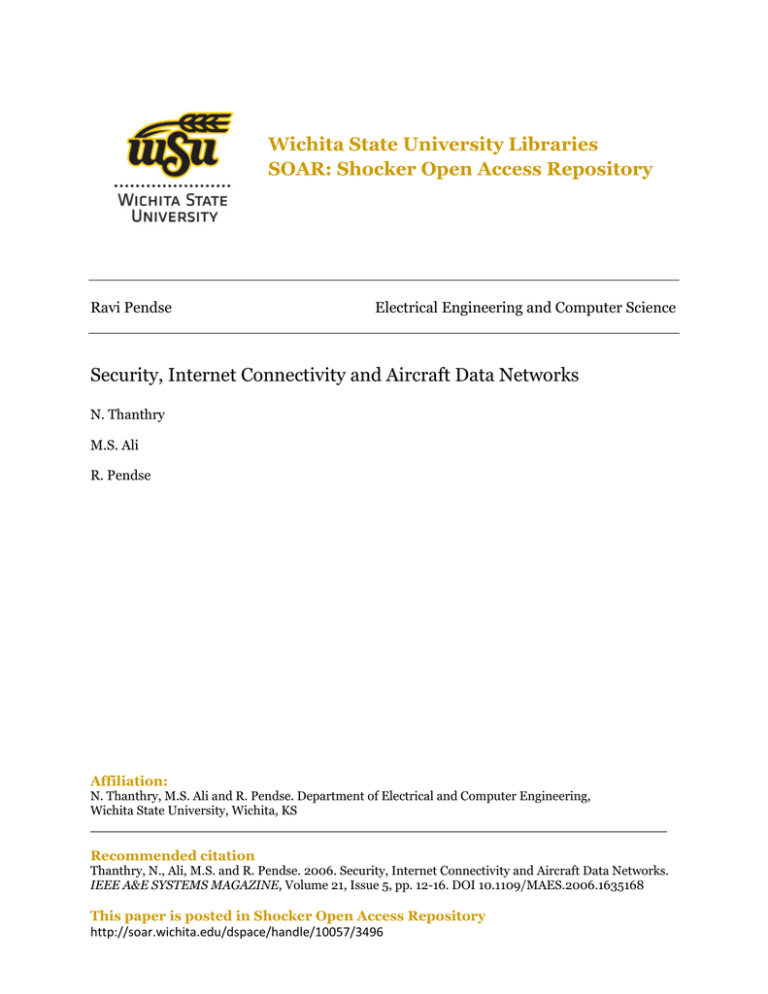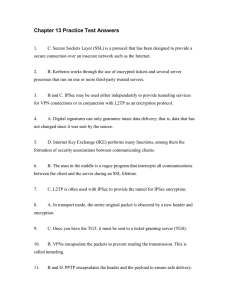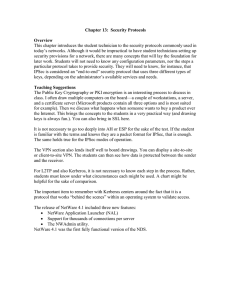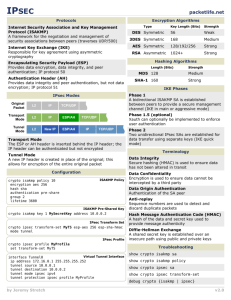Wichita State University Libraries SOAR: Shocker Open Access Repository
advertisement

Wichita State University Libraries SOAR: Shocker Open Access Repository Ravi Pendse Electrical Engineering and Computer Science Security, Internet Connectivity and Aircraft Data Networks N. Thanthry M.S. Ali R. Pendse Affiliation: N. Thanthry, M.S. Ali and R. Pendse. Department of Electrical and Computer Engineering, Wichita State University, Wichita, KS _________________________________________________________________ Recommended citation Thanthry, N., Ali, M.S. and R. Pendse. 2006. Security, Internet Connectivity and Aircraft Data Networks. IEEE A&E SYSTEMS MAGAZINE, Volume 21, Issue 5, pp. 12-16. DOI 10.1109/MAES.2006.1635168 This paper is posted in Shocker Open Access Repository http://soar.wichita.edu/dspace/handle/10057/3496 §e�1lllrifty? llnnfteIrllTleft COllTlnne�ftfivfifty atnnrll AfiIr�Iratjfft ]JJ)at11a NeftwoIrks N. Thanthry, M.S. Ali & R. Pendse Wichita Stnte University ABSTRACT commercial airliners like Lufthansa, Scandinavian Airlines, Internet connectivity which was in experimental stages only a few years ago is a reality today. Current implementations allow passengers to access Internet for pleasure and in some cases secure VPN access is provided to corporate networks. Several researchers are looking at the possibility of the existence of a total of three networks: passenger network (PN); crew network (CRN); and the control network (CON). Researchers envision an architecture where these three networks will co-exist in an airplane. The available Internet connectivity can be utilized for transporting flight critical information like cockpit flight data recorder (CFDR) data, digital flight data recorder (DFDR) data, cockpit voice recorder (CVR) data, and controller pilot data link communication. In addition, the internet connectivity could also be used for other safety mechanisms like video surveillance and remote control of the flight. Security is one of the major concerns that affect the successful deployment of Aircraft Data Networks (ADN) and other safety features. Several studies have been carried out to secure the network using fJl"ewalls and intrusion detection system but so far no study has focused on securing the communication channel (between the aircraft and the gronnd station) and its impact on the ADN. The scope of this research is to determine the v iability and need of a security mechanism. The research will also focus on the performance of different security architectures and determine their usability in the framework of an ADN. INTRODUCTION , Author's Currenl Address: N, Thanthry. M.S. Ali and R. PeDdse. Department of Electtica! and Computer Engineering, Wichita Slate University. 1-845 N Fairmount, Wichita, KS 67260, USA. Based on a preseQtation at Carnahan 2005. 12 . , Due to the recent technological adva ncem ents d epl oyment of Aircraft data networks (ADN) is on the rise. Many 0885189851061 S17.00 Cil2006 IEEE China Airlines, and Singapore Airlines have already deployed ADN in their selected long haul flights. It is expected that, in the next 20 years, there will be 100,000 flig hts enabled with ADN flyin g across the world. With this volume of deployment, ADN security raises one of the major concerns for the authorities as well as airliners. As pointed out by the authors of [1], aircraft data networks faces two kinds of security threats: internal and external. Internal security threats are ori gi nated from the passenger network where a malicious user can gain access to the control network and cause service impairments and/or attempt to take control of the flight On th e other hand, the external security threat is caused due to the security vulnerabilities of the satellite links. Aircrafts equipped with ADN use satellite links to connect to the ground station. The advantages of satellite links lie in their ability to c over a large geographic area, distance insensitivity, and immunity to terrestrial hazards. Satellites are useful in providing broadband connectivity to remote locations which are h arder to reach through terr estria l infrastructure. While satellite communication is ad vanta g eou s, it has some peculiar characteristics like high delay-bandwidth product, low signal-to-noise ratio, long feedback loop, transmission error, variable Round Trip Time (RIT), and intermitten t connectivity . These characteristics affect the communication, e specially internet protocol (IP) based communication passing via the satellite network. A number of researchers have worked on imp roving the IP based communication performance over satellite networks. One of the solutions proposed in this area suggests using performance enhancing proxies (PEP) [3,4] at strategic locations. Apart from performance degradation the satellite networks are also prone to security attacks. Due to their broadcast nature, satellite networks are prone to security threats like eavesdropping and flooding [5 7]. Usag e of IPSec is one of the many solutions proposed to secure satellite communication. The versatility of IPSec lies in the fact that, unlike the other schemes which operate at the transport or applicat ion layer, IPSec operates at the Network layer thereby making it very easy to apply this security solution to different applicatio ns and with different transport layer protocols. Other - lEEE A&E SYSTEMS MAGAZINE, MAY 2006 security mechanisms suggested for satellite communication include Transport Layer Security (SSUILS), Secure Shell (SSH), and Pretty Good Privacy (PGP), etc. However, the choice of security protocol depends upon the data type and the capacity of the encrypting device. In this paper, the authors analyze the ADN traffic pattern and look at various security options available for each data type. The main focus of the authors will be on the security mechanisms like IPSec and SSUfLS. The remainder of this paper is organized as follows: in the section that follows, the authors pr esent a brief overview of IPSec and SSLffLS security mechanisms. In the section entitled Aircraft Data Network Traffic Pattern, the authors present a discussion on the typical traffic pattern of ADN. In the section entitled Security Mechanisms andADN, the authors discuss the advantages of each security mechanism with respect to ADN. In the Simulated Results section, the authors compare the performance of the two contending security mechanisms through simulation results. In the final section, the authors present their conclusions and suggest some future work. such as data encryption s tandard (DES). Key exchange protocols are another important part of IPSec. Key exchange protocols such as internet key exchange (IKE) [10] ensure that the end points exchange the encryption and decryption keys securely. IPSec operates in two different modes based on the security requirement. When operating in the transport mode, IPSec encrypts only the payload part of the IP packet. In tunnel mode, IPSec encrypts the entire IP packet and appends the encrypted IP packet with a new IP header specifying the address of the tunnel end point. The tunnel mode of IPSec offers maximum data security. In order to provide enhanced security, IPSec induces some additional information (overhead) into the IP packet. IPSec overhead consists of IPSec header (24 to 57 bytes), authentication header (24 bytes in transport mode. 44 bytes in tunnel mod e) and/or ESP header (30 - 37 bytes in transport mode and SO - 57 bytes in Tunnel mode). In addition to the packet overhead, the IPSec encryption process also delays the entire packet delivery process and this delay depend s upon the complexity of the encryption algorithm used by the IPSec process. OVERVIEW OF SECURITY MECHANISMS Overview of SSLII'LS Security is one of the major issues faced by most of the network administrators. Many schemes have been developed to address the security concerns of end users. It has been noticed that an enhancement in the security oftentimes adversely affects the application quality as perceived by the end users. Hence it is important for the end users/network administrators to choose the security mechanism that best suits their requirements. In the case of an ADN, there are various types of traffic flow between the ground station and the aircraft. While some of this information may correspond to the flight control, others may be Originated by the passengers. Typically, IPSec-based security mechanisms are used to protect sensitive information traversing the network. However, in the recent past, security mechanisms based on Secure Socket Layer (SSL) are also gaining importance due to their versatility. Overview of IPSec IPSec-based encryption is one of the means of providing security to confidential information. The versatility of IPSec lies in the fact that, unlike the other schemes which operate at the transport or application layer, IPSec operates at the Network layer. This makes it very easy to apply IPSec-based security mechanisms to different applications and different transport layer protocols. IPSec offers authentication along with data encryption. IPSec achieves data security using three distinct components, each handling different aspects of security. Authentication header (AR) [9] is responsible for data authentication. Encapsulating security protocol (ESP) [8] is responsible for maintaining the data confidentiality. ESP defines the encryption mechanism, data format, etc. to ensure data confidentiality. Generally IPSec uses encryption algorithms IEEE A&E SYSTEMS MAGAZINE. MA Y 2006 Compared to IPSec-based security mechanism, SSLfI'LS is a newer security protocol (in terms of site-to-site access) developed initially by Netscape for web browsers. Unlike IPSec, SSLfTLS uses a layered approach. The record layer operates above the transport layer and provides encryption and authentication services. SSLlTLS uses symmetric key algorithms to protect user data. The keys to these algorithms are established by the handshake method which is handled by the handshake protocol. The handshake protocol uses public-key algorithms to create a master key between the SSUfLS client and the server. The master key is used to generate cipher keys, initialization vectors, and message authentication code (MAC) keys. In addition to handshake protocol, there are other protocols like Change Cipher Spec (CCS) protocol, Alert protocol, and application data protocol which operate at the same level as handshake protocol. CCS protocol monitors the successful completion of handshake, whereas Alert protocol is responsible for notifying the protocol failures. The application data protocol is responsible for handling data to/from the higher layers. Similar to IPSec, SSLffLS accommodates a variety of encryption (DES, RC4), hashing (MDS, SHA), and key management (RSA, DH) algorithms. However, the standard specifies the usage of a specific combination of these security algOrithms called cipher-SUites in order to get a specific security effect. Whenever a client wants to connect to a server, he/she first sends a hello message to the server. In response, the server sends a server hello message. This exchange of hello messages sets parameters like version, session !D, encryption method, and compression technique. Once this part is done, both client and server authenticate each other after which they exchange the session key. It has been observed that, with a Pentium Xeon 13 processor, this entire handshake process takes approximately 173 ms [17]. After the handshake process is complete, the client and server are ready to exchange application data. In cockpit voice are sensitive information as compared to other traffic. Hence, they need to be protected against attack from . extemal entities. addition to the handshake delay, typically SSUTLS adds at Previous research in this field has in di cated that real-time least 23 b ytes (depends upon the block Cipher used and block transmission of these information segments from the aircraft to size). However, there is no clear definition of the number of the bytes added per packet in the case of SSUTLS. ground station not is viable due to the high delay-bandwidth product of the satellite links. It was observed that almost all of the TCP-based data transmission applications A IRCRAFT DATA NETWORK TRAFFIC PATTERN suffered performance degradation due to the variable RTf and high delay of the satellite links. One of the possi ble solutions in As mentioned earlier, in addition to transporting passenger traffic, the available Internet connection could also be used to this direction could be to use a streaming based data transmission between the aircraft and the ground sta tion . In transmit certain flight parameters from the aircraft to the this scenario, the data collected from the CVR and DFDR are ground station. Currently, every aircraft stores approximately stored within the aircraft 15 minutes of cockpit voice information in the CVR. Every 15 downloaded to the ground station. In order to improve TCP and at regular interval s, and minutes, this information is overwritten with the new data. As performance, researchers have suggested using performance discussed in [16], with the recent technologi cal advances, it is enhancement proxies (PEP) at strategic locations. possible to store the flight information for the entire flight PEPs are generally located at the edge of the satellite duration within the aircraft. In addition, using the Internet networks. PEP agents act connection, this information could be transferred to the ground ACK messages for the data that passes through them. TCP PEP station in real-time, enabling the ground station crew to agents extract the TCP flow identification information and the as proxy agents by sending proxy monitor the flight health and caution the flight crew in case of sequence number from every TCP packet that passes through an emergency. them. This data is used to form the proxy ACK message. Using PEP agents reduces the possibility of the source getting into slow start mode due to delayed acknowledgements. IP Header Tep Header ESP/AD In the next section, the authors discuss the effect of different ESP TRL DATA security mechanisms on the performance of ADN traffic. SECURITY MECHANISM AND ADN In general, the perception is that the security mechanism Fig. lA. Encrypted IP datagram in transport mode deteriorates the application performance, which is partly true also. One of the main reasons for this is the complexity of the IP Header mew) ESPIAH IP Header TCP Header (Old) security mechanism itself. As the complexity of the security ESP TRL DATA mechanism increases, the perceived security will also increase. On the other hand, with lower end systems, it affects the quality adversely. In the case of ADN, the quality of aircraft traffic is affected by two factors: sat ellite link and security mechanism. The Fig. lB. Encrypted IP datagram in tunnel mode effect of the satellite links can be alleviated by using Fig. 1. Encrypted IP packet improve the TCP-based application performance, they do not performance enhancement proxies (PEP). While PEP agents work well in the presence of network layer encryption. When In addition to the flight information stored in the black box, an end-lo-end encryption mechanism like IPSec is used, the the available Internet connection could also be used to transmit encryption scheme hides all the information including the video frames captured within the aircraft to the ground station transport layer header from the intermediate nodes. However, in real-time in emergency situations. Passengers may use the in order for PEP agents to work, they will need the transport available internet connection to browse through the internet for layer information. This results in non-functioning of the PEP entertainment (streaming audio/video), or to connect to their agents. Figure 1 shows the typical packet format of an corporate network. Depending upon the passenger volume, the encrypted IP datagram. As shown in the figure, the PEP agent amount of data generated from the passenger network varies. It could get just the IP header information but not the TCP header has been noted that, DFDR stores approximately 122 Kbytes of information. data in 15 minutes, where as digitization of cockpit voice communication bandwidth. requires approximately If implemented. video 136 traffic may The issue of IPSec and PEP coexistence was first identified of by the authors of [15]. In their work, the authors explored many require possible solutions to resolve the issue of security and kbps approximately 865 kbps of bandwidth. From the traffic profile, performance enhancement working together. One of the it can be observed that the data corresponding to DFDR and possible solutions they proposed suggested that IPSec-based 14 IEEE A&E SYSTEMS MAGAZINE. MAY 2006 Satellite Link SimwatrJr End Host Gateway Gateway PEP Agents Fig. 2. Simulation test-bed encryption should be used selectively They suggested that the traffic streams that need performance enhancement should n ot Table 1. Throughput measured using netperf (Mbps) . be encrypted. The major drawback of this approach is that it compr omises the security of traffic user for better performance . In another suggestion, the same authors suggested establishing multiple IPSec associations. In their With PEP Without PEP proposed approach, the authors su g gested that the PEP agents s ho uld be used as IPSec e nd points. The end systems need to Normal Scenario 6.7 Normal Scenario 0.61 1.77 0.5925 o 0.5975 1.76 establish security association with the PEP agents. PEP agents will have certain IPSec-based security association between themselves, and they will transport user data across the satellite with Satellite Link Impairments network after applying encryption. This method requires a distributed PEP implementation, and it also requires the end systems to know the presence of PEP agents. The major IPSec-based drawback of this approach is its complexity. This approach involves multiple encryption/decryption Encryption processes which increase the delay and reduce the throughput. SSLffLS-based Another approach suggested by these authors was to use Encryption other encryption techniques like SSUfLS instead of IPSec. SSLfILS-based encryption p rovi des almost the same level of security as IPSec but operates at the tran sport layer instead of the network layer. As discussed earlier, SSUfLS supports shown in Figure 2. The authors used a satellite link simulator almost all encryption standards similar to IPSec. However, (by Spirent Communications) to emulate the satellite link since it is encrypting at the transport layer level, it will leave characteristics in the network. In addition, the authors also the transport layer information unencrypted thereby opening used up the network for attack. On the other hand, it does not hinder SCPS.org. All the systems u sed in the test-bed were of the performance enhancement proxies availed (PIlI, 800 MHz, 256 MB RAM). from the operations of the PEP agents, thereb y improving the quality same configuration of the data transfer applications. Hence from application authors compared the throughput perfonnance (using netp erl) perfonnance option of the network under various conditions i.e. in a normal In the next section, the authors present some simulation of performance enhancem ent proxies. Table 1 presents the perspective , SSlITLS is a better scenario, with satellite link simulat or active and in t h e presence compared to IPSec. results to support their argument of choosing SSlITLS-based security mechanism for ADN. From the results, it can be observed that the through pu t of In order to verify the advantages of SSlIfLS-based security IEEE A&E SYSTEMS MAGAZINE, MAY 2006 results obtained under different test conditions. the SIMULATION RESULTS mechanism over IPSec, the authors built a small test-bed The as networ k was almost similar for both IPSec and SSUfLS-ba sed security mecha nisms . However, in the presence of PEP, only SSLffLS-based security mechanisms were able to deliver the data across the network while packets encrypted using IPSec were dropped at the PEP gateways. This 15 clearly indicates that SSUTLS-based security mechanisms are better in the presence of satellite links and performance e nhancement proxies. White Paper. GSEC Practical Assignmen t, Version: l .4b, SANS Institute. 2003. [7] Critical Infrastructure Protection: Commercial Satellite Security Should Be More Fully Addressed, CONCLUSIONS AND FUTURE WORK Highlights ofGAO-02-781, a report to the Ranking Minority Member, Permanent Subcommittee On Investigations, In this research work, the authors focused on determining the security mechanism best suited for aircraft data networks. They compared the working of IPSec- and SSUILS-based security mechanisms. While IPSec provides better security, i t fails to maintain the quality o f service required b y the TCP-based applications. On the other hand, SSUILS-based security mechanisms provide security almost equivalent to IPSec without affecting the quality to a larger extent. Hence, in the current conditions, SSUTLS-based security the authors mechanisms suggest for using aircraft Committee on Governmental Affairs, United States Sen.te. Augusl 2002. [8) S. Kent and R. Atkinson, IP Encapsulating Security Payload (!!SP). RFC 2406, November 1998. www.faqs.orglncslrfc2406,html, [9) S. Kent and R, A tkin son, Authentication He.der, RFC 2402, November 1998, www.faqs.orglrfcslrfc2402,htrnl. data [10) D. Harkins and D, Carrel, networks. One of the main drawbacks sited in the case of IPSec was its inability to provide transport layer information to the PEP agents. As a future work, the authors suggest making modifications to the existing IPSec key exchange protocol such that IPSec works along with PEP agents to improve the The (ntemet Key Bxchange (IKE), RFC 2409, November 1998. www,faqs,orglrfcslrfc2409,htrnL [11] E, Rescorl., SSL and TLS: Designing and Building Secure Systems, Addison-Wesley. 2001. application performance in satellite link environments. [12) T.R. Henderson and R.H,Katz, Transport protocols for [ntemet-compatible satellite networks, REFERENCES IEEE Journal on Selected Areas of Communication, Vol. 17, pp,326-344, February 1999, [1] N, Thanthry and R. Pendse, Aviation Data Networks· Security Issues and Network Architecture, · In the Proceedings of 38 htlemational Carnahan Conference On Security Technology, 1997. [3) 1. Border. M. Kojo, 1. Gri ner and G, Montenegrc, Perfonnance Enhancing Proxies, Internet Draft, December 1999, [4) J, Grinner, TCP Performance Enhancing Proxy Terminology. Internet Draft, November 199&, httpJltcppep,lerc.nasa,gov, [5] Y. Zhang, D. DeLucia, B, Ryu, and S. Dao, Satellite Communications in the Global Internet Issues, Pi Ifalls, and Potentials, In the Proceedings of INET'97, June 1997, [6] M, Med.war, S.tellite Security; The Weakest Link?, link-related degradations, [14] S. Kent and R. Atkinson, [2] C. Partridge and T, Shepard, IEEE Network, Vol. II, No . 5, pp. 44-49, September Performance enhancing pro,ies intended to mitig.te RFC 3135, June 2001, www.ietf.orglrfclrfc3135,txt, Albuquerque, New Mexico, October 2004. TCP Performance over Satellite Links, 113] J. Border, M. Koj o, 1, Griner, G, Montene gro. and Z, Shelby, Security architectme for the Internet protocol , RFC 2401, November 1998, http://www.faqs,orglrfcslrfc2401,hnnl. [IS) Y. Zhang, A Multi·Layer IP Security Protocol for TCP Performance Enhancement in Wireless Networks, IEEE J01U1lal on Selected Areas in Communications, 22(4):767-776, May 2004, [16] V. Ragothaman. N. Thanthry, R, Bhag.vathula and R. Pendse, IP Connectivity and DAP, In the Proceedings of 23" Digital Avionics System Conference, Salt Lake City, Utah, October 2004. [17] V. Beltran, 1. Guitar!, D. Carrera, 1. Torres. B, Ayguad and], Labarta, Perfonnance Impact of Using SSL on Dynamic Web Applications. In XV lornada. de Paralelismo, pp. 471-476. Almeria. Spain, (September 16 2004). .4 !EEE A&E SYSTEMS MAGAZINB, MAY ZOO6



